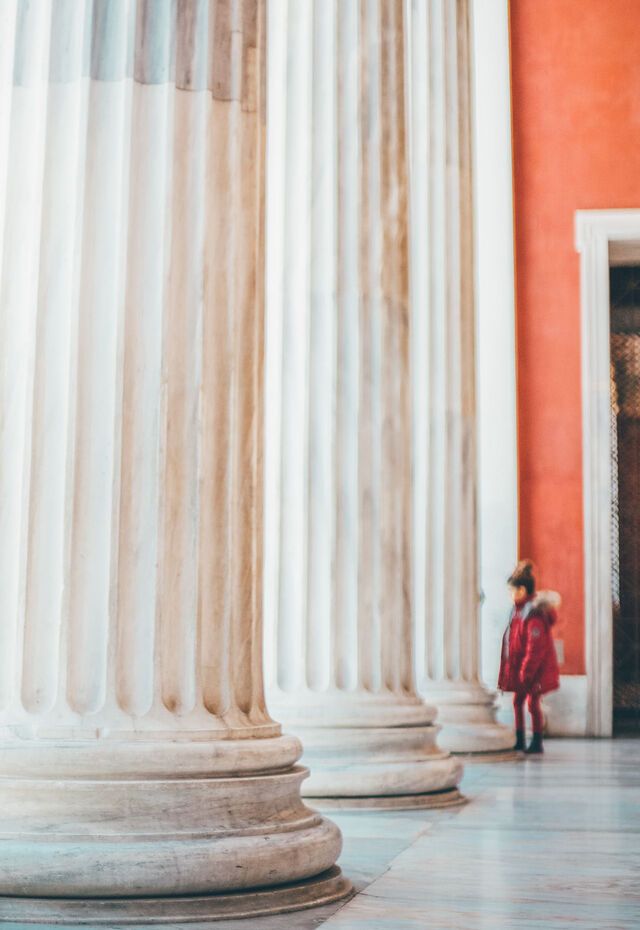With so much to see, it’s worth deciding on the exhibits you want to focus on or being aware of the highlights before you visit.
Prehistoric Antiquities (Halls 3-6, 48)
Including Neolithic and Bronze Age works from the Aegean islands and mainland, this collection includes treasures from the Royal Tombs of Mycenae (including the Mask of Agamemnon), the Linear B tablets from Knossos, famous frescoes from Akrotiri in Thera (the super-island that Santorini once belonged to) and the enigmatic Cycladic marble figurines that look more like exquisite artwork than ancient artefacts. It covers a quite astonishing period of time, from the 7th millennium BC through to around 1,050 BC.
Sculpture (Halls 7-35)
From 700 BC to the 5th century AD, sculpture was the art-form of choice in Greece – in sanctuaries, necropolises or public buildings. There are examples from the Archaic period (in the form of marble votives) and the Hellenistic period (late 4th century BC to early 1st century AD, before and after Alexander the Great and the great Macedonian empire) … and on to the Roman period, up to the 5th century AD. But the heyday of sculpture in ancient Greece was in the 4th-5th century Classical period when, under Pericles, the Parthenon and so many of Athens’ greatest monuments were built and great sculptors flocked into town to create masterpieces that drew inspiration from the human body and imparted idealised beauty and spiritual meaning.
Metalwork (Halls 36-39)
The National Archaeological Museum’s Bronze collection is considered one of the finest of its kind. There are thousands of artefacts on display, most unearthed in 19th and early 20th-century excavations, including male and female figurines, mythological creatures and animals. Look out for the weapons and other artefacts from the Shipwreck of Antikythera, including the famous Mechanism (a 1st-century BC scientific navigation instrument likened to a computer). Other highlights are the Artemison Bronze, standing at more than 2m tall and depicting either Zeus or Poseidon in combat mode, and the Jockey of Artemison (150 BC), a rare depiction of a racehorse in Greek sculpture.
Vases And Minor Arts (Halls 49-57)
More than 6,000 mostly illustrated objects take you from the 11th to 4th century BC. You’ll learn about the original migration of populations across the eastern Mediterranean and the Mycenaean influences, followed by the rapid 8th-century BC population growth (and with it trade) and the birth of the city-state and all the subsequent types of rule (aristocracy, oligarchy and tyranny). And you’ll witness the rise of sporting institutions, such as Panhellenic Games at Olympia as long ago as the 8th-century BC and the Pythian Games in Delphi, Isthmian Games in Corinth and Nemean Games in the Peloponnese two centuries later.
Egyptian Antiquities (Halls 40-41)
As well as covering the full plethora of Greek history, the museum also has an extensive Egyptian collection exploring the ancient dynasties that thrived along the fertile Nile River valley. Largely donated by two expatriate Greeks living in Egypt in the late 19th and early 20th century, the collection includes artefacts from Pre- and Early Dynastic Egypt 5400-3000 BC through to the Ancient Kingdom (2575-2134 BC) that centred around the worship of the Sun God and the Middle Kingdoms (2010-1640 BC) when the Pharaohs used Thebes as their seat.
Cypriot Antiquities (Hall 64)
Finally, to Cyprus with around 850 objects representing the full spectrum of Cypriot history and art (from the Early Bronze Age to the Roman period). Throughout that time, Cypriot craftsmen showed themselves adept at metallurgy and pottery, incorporating Mycenaean elements along with other influences from the Aegean and the East, particularly with Cyprus strategically placed on ancient trade routes.





